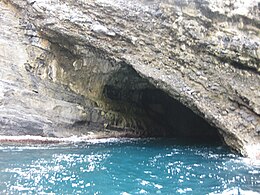Palmaria (island)
| Native name: Isola Palmaria | |
|---|---|

The Blue Cave
|
|
| Geography | |
| Location | Ligurian Sea |
| Total islands | 1 |
| Major islands | Palmaria, Bergeggi, Gallinara, Tino and Tinetto |
| Administration | |
|
Italy
|
|
| Region | Liguria |
| Province | La Spezia |
| Official name | Portovenere, Cinque Terre, and the Islands (Palmaria, Tino and Tinetto) |
| Type | Cultural |
| Criteria | ii, iv, v |
| Designated | 1997 (21st session) |
| Reference no. | 826 |
| State Party | Italy |
| Region | Europe and North America |
Palmaria is an Italian island situated in the Ligurian Sea, at the westernmost end of the Gulf of La Spezia. Measuring 1.6 square kilometres (0.6 sq mi), it is the largest island of an archipelago of three closely spaced islands jutting out south from the mainland at Portovenere. The other islands, Tino, and the tiny Tinetto lie further south.
In 1997, the archipelago, together with Portovenere and the Cinque Terre, was designated by UNESCO as a World Heritage Site.
The Palmaria island with a surface area of 1.89 square kilometres (0.73 sq mi), is the largest of three islands in the Gulf of La Spezia and the Liguria region of the whole, the other two islands, Tino and Tinetto meet down a few hundred meters straight line to the south. The island has a triangular shape: the sides that face Portovenere and the Gulf of La Spezia are the most humanized and slope gently down to the level of the sea, covered by typical Mediterranean vegetation, the side that faces west, i.e. towards the open sea, is instead characterized by high cliffs overhanging the water, in which there are many caves. The sides humanized see the presence of some private homes, a restaurant (in Pozzale) and especially bathing establishments, both public and confidential employees of the Navy and Air Force. As for the western side, the most difficult to reach, are worthy of note the Blue Cave, visited by boat, and the Cave of Pigeons, which can be reached only by climbing down ropes. The latter in particular has been very important in the study of historical events in the Gulf, as have been found inside the fossilized bones of animals such as chamois and the snowy owl, but above all remains of human burials, testifying the presence of man at least five thousand years ago. On the island there are also many buildings of a military character and of great historical interest: the top, inaccessible as a former military area and is currently in a state of neglect, the Fort Count of Cavour (or Fort Palmaria), the battery now used as experimental environmental education center and Batteria Semaforo near the Scola Tip, the tower ironclad Umberto I and used in World War II to a military prison and renovated a few years ago and the remains of the battery Albini, scattered throughout the island, several bunkers from the Second World War and the remains of coastal artillery and antiaircraft mostly inaccessible since abandoned and submerged vegetation. Remarkable is the presence (in the south, called Pozzale) of an abandoned quarry, once used for the extraction of the precious black marble with streaks of gold portoro said. There are still remnants of cranes and hoists used for moving the blocks of marble and the walls of the houses of the miners.
...
Wikipedia

